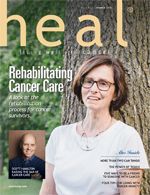Rehabilitating Cancer Care
“The most important thing for survivors to understand is that they deserve the opportunity to function optimally no matter their cancer.”
Head and neck cancer survivor PAULA EINAUDI would like all survivors to have access to rehabilitation services after their treatment ends. - PHOTO BY LAUREN SHEINTAL

Head and neck cancer survivor PAULA EINAUDI would like all survivors to have access to rehabilitation services after their treatment ends. - PHOTO BY LAUREN SHEINTAL
In 1997 Paula Einaudi served as the development director for the Johns Hopkins University School of Nursing in Baltimore where she met with donors, held events and garnered corporate support for the school.
As a swimmer and a runner, she says she was “smug” when her dentist found a lump in her neck and suggested she have it checked out. But good health didn’t deter the diagnosis of cancer.
“The primary site was the base of my tongue,” she adds. “Two days later I underwent neck dissection to remove the cancerous secondary site, including 22 lymph nodes. Then I started 35 radiation treatments, which just about did me in.”
Einaudi had a hard time accepting that the surgery and treatment made her look as though she had had a stroke. "I had no smile on the right side; I couldn’t open my mouth very far, and had a scar from my Adam’s apple to halfway up my ear. I also couldn’t raise my arm.”
Helping her through treatment and aftermath was a friend from college, Lynn Gerber, the chief of the Rehabilitation Medicine Department at the Clinical Center, National Institutes of Health in Bethesda, Maryland.
It was a fortuitous friendship since Gerber probably knew more about cancer rehabilitation than most anyone in the country after participating in cancer research at the National Institutes of Health (NIH) for more than 20 years at that point. Indeed, when she started calling physical therapists who could provide therapy to Einaudi closer to her home in Columbia, Maryland, she finally found someone eager to learn and more than willing to follow her directions about which exercises would help.
Einaudi says neither her surgeon nor radiation oncologist talked about rehabilitation. She says when she brought it up with her surgeon, he just looked at her and said, “We would have gotten around to that.”
By 1997, Gerber had already been at the NIH for two decades working with experts on functional outcomes when the new surgeries and chemotherapy were introduced. Gerber says rehabilitation, which aims to promote or restore function and to prevent functional decline, is likely to make an important impact on function during and after cancer treatment, says Gerber, who today continues her research in the College of Health and Human Services at George Mason University in Fairfax, Virginia.
No one would argue that cancer rehabilitation has made progress since Einaudi’s diagnosis, but not nearly enough, according to those in the field and the patients they help. As with any new recommendation in the medical world, particularly one where equipment and a new specialty is required, there has to be a mountain of research to inform doctors about effectiveness and provide guidelines based on data. This will promote effective treatment and support reimbursement and, hopefully, encourage more health professionals to gain expertise in the practice of cancer rehabilitation. The medical profession and the insurance companies have still not totally accepted the role for rehabilitation, even today.
Part of that challenge, says Lynne Padgett, strategic director of the Hospital System for the American Cancer Society, is that people still think of cancer rehabilitation as just managing lymphedema, the swelling that may occur after an axillary dissection for mastectomy.
“It goes far beyond that to include things such as the ability to walk and occupational functioning such as managing daily tasks,” she says. Padgett works with 11 divisions, prioritizing and providing resources for effective treatment and follow up.
“I think the reason we are not moving faster is that the doctors and patients during treatment are focused on cure, they want to know what to do to get rid of the cancer,” she says. So, ironically, doing well with new treatment options has resulted in increasing numbers of patients. “Now we are starting to see the limitations, as patients are ready to move on and just accept the pain, or whatever the challenge is, as part of life.” The other piece is that providers have a lack of awareness that they can make a difference in functional level, helping patients return to what they need and wish to do in their lives because they don’t discuss it, and patients don’t know how to ask or tell them what it is they need.
Padgett tells the story of a woman who was successfully treated for early-stage breast cancer.
“She traveled for work, and over time, her impaired range of motion in her shoulder began to impair her ability to drag a suitcase and put it in the overhead. She wrote it off as the new normal after cancer,” Padgett says. “A business colleague recommended rehabilitation, and she saw an occupational therapist who improved her range of motion and helped her resume her responsibilities.” It was an irritation that had a significant impact on her quality of life, and it speaks to the physical functioning of everyday life, Padgett says. “They are willing to see it [physical impairments] as the price they pay for being cured,” she says.
Growing Importance
Over the past decade, the importance of rehabilitation has grown due to the expectations of patients and medical professionals that quality of life will be taken into by consideration by accrediting groups. It is now listed among the services that must be made available by cancer centers accredited by the American College of Surgeons’ Commission on Cancer, which accredits more than 1,500 cancer programs in the United States and Puerto Rico. But what constitutes a cancer rehabilitation program have not yet been specified.
In addition, the National Comprehensive Cancer Network’s guidelines say “rehabilitation should begin with a cancer diagnosis and should continue even after cancer treatment ends” to lessen fatigue, identified as one of the most common symptoms reported by survivors.
The most comprehensive rehabilitation approach, the STAR Program, was created by Julie Silver, today an associate professor at Harvard Medical School in the Department of Physical Medicine and Rehabilitation and the associate chair for strategic initiatives at Spaulding Rehabilitation Hospital. The program allows for evaluation after treatment to triage patients to the appropriate rehabilitation, whether it’s physical, occupational or another therapy.
Silver and her team created the STAR Program in response to her own rehabilitation needs after a diagnosis of breast cancer in 2003. It is designed to guide hospitals, cancer centers and health care facilities through the process of developing and implementing a multidisciplinary oncology rehabilitation service line focused on four key outcomes categories: Access to Care, Patient Function, Patient Satisfaction and Clinician Education. Today, the program can be found in 200 hospitals, many of which are underutilized.
“The challenge is still that physicians are not telling patients that the services are available, that they can be assessed for impairment and triaged to the medical care they need, including rehabilitation,” Silver says, adding that this means the vast majority of patients and survivors are still undertreated for deficits common to cancer.
Patients Respond
At one point in the interview with Paula Einaudi, she asked if this story would be negative about her doctors for not recommending rehabilitation. She didn’t want to be at all negative about the doctors who she saw as saving her life, repeating a concern that speaks to why more patients don’t bring needs pertaining to function and overall well-being or complain to their physicians when they discover on their own how helpful rehab is to them. Patient communication could go far in helping physicians change their attitudes. “Throughout my ordeal, Lynn was my lifebuoy,” Einaudi says.
“She lifted my spirits, gave me advice about food and exercise, and suggested the key questions for me to ask my doctors. Without those questions, in fact, I am not sure I would have gotten the physical therapy that was so critical to my rehabilitation. “I don’t want to sound ungrateful. I just never got the impression that they cared about rehab at all.”
But despite all the requirements, patients still don’t know what is out there and whether they need rehab, Padgett says. “They don’t have any kind of systematic way to understand, and even if they did, patients wouldn’t know.”
Where to Now?
The Institute of Medicine has defined four “pillars” of survivorship care:
1. Surveillance for recurrence
2. Intervention for treatment consequence and late effects
3. Prevention of recurrence, new cancers, late effects and comorbidities where possible
4. Coordination of care between primary care, oncology and other specialists.
Comprehensive cancer rehabilitation delivered using a multidisciplinary team is an essential component of survivorship care that addresses these four pillars. Patients should have these discussions early on as the treatment plan is being formulated.
Silver says most cancer patients will benefit from rehabilitation. The challenge is communicating that information and then finding a way to engage the physicians so they will look at the options and find a way to provide the care in the right way. “The most important thing for survivors to understand is that they deserve the opportunity to function optimally no matter their cancer. Part of that is receiving excellent cancer rehab services that are covered by medical insurance and involve rehabilitation professionals.”
